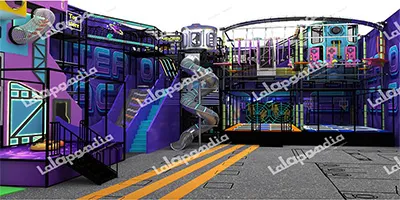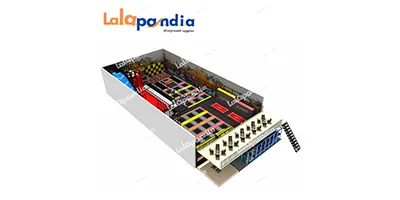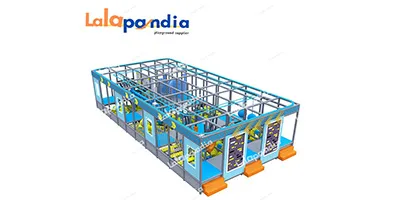2025.08.09
Posted By: Peter
Designing a mall playground is a multifaceted task that requires careful consideration of various factors to create a space that is not only fun and engaging but also safe, functional, and profitable. From understanding the available space to selecting the right equipment and finding reliable suppliers, each step plays a crucial role in the success of the playground.
The first step in designing a mall playground is to thoroughly assess the available space. Malls typically have limited and specific areas allocated for such facilities, so it's essential to make the most of every square foot.
Measure dimensions: Start by measuring the length, width, and height of the space, as these will determine the types and sizes of equipment that can be installed.
Consider foot traffic flow: The playground should be easily accessible to families but not positioned in a way that disrupts the normal movement of other shoppers.
Plan separate zones: Designate areas for different age groups and activities. For example, a toddler area with soft play equipment should be separated from a more active zone for older kids to prevent collisions and ensure safety.
Include amenities: Think about the placement of seating for parents, restrooms, and storage areas for coats and bags. These elements contribute to the overall convenience and comfort of the users, making the playground more appealing.
Safety is paramount when designing a mall playground. There are strict safety regulations and standards that must be followed to protect the children using the facility.
Familiarize with safety codes: Learn about local, national, and international safety codes, such as those set by the Consumer Product Safety Commission (CPSC) in the United States or the European Committee for Standardization (CEN) in Europe.
Key safety considerations:
Use non-toxic and durable materials for equipment.
Provide proper padding and surfacing to minimize the risk of injury from falls.
Ensure all equipment is installed correctly and securely.
Regular inspections and maintenance: These are essential to identify and address any potential safety hazards promptly.
Post rules and guidelines: Clear rules help ensure that children and parents understand how to use the equipment safely.
Identifying the target audience is crucial in designing a mall playground. The equipment and activities should be tailored to their needs and interests.
Define target age groups: Determine if you're catering to toddlers, young children, or a mix of age groups.
Toddlers may enjoy soft play areas, ball pits, and small slides.
Older children may prefer more challenging equipment such as climbing walls, trampolines, and ninja warrior courses.
Choose a theme: A theme can make the playground more engaging and memorable, such as a jungle adventure, space exploration, or a fairy tale kingdom.
Incorporate the theme into the design of the equipment, color scheme, and overall decor.
Ensure the theme is age-appropriate and appeals to the target audience.
Indoor playground equipment comes in a variety of types, each suited for different age groups and purposes.
Soft play structures: Ideal for toddlers and young children, providing a safe and padded environment for crawling, climbing, and exploring.
Slides: Available in different sizes and styles, from small straight slides for toddlers to larger spiral slides for older children.
Climbing frames: Can be designed to challenge children's physical abilities and coordination.
Ball pits: Offer a fun and sensory experience.
Interactive games: Such as video games, air hockey, and mini-golf, adding an extra element of fun for older children.
When selecting indoor playground equipment, consider the age range of the target audience, available space, and safety standards. Choose durable, easy-to-clean equipment that meets all relevant safety requirements.

Trampoline parks have become increasingly popular and can be a great addition to a mall playground.
Main Court: Interconnected trampoline beds with padded walls. Requires significant space and ceiling height (often 18-25 ft min).
Specialty Areas: Foam pits (strict landing procedures!), dodgeball courts, basketball slam lanes, performance tramps, tumble tracks.
Safety: Paramount. High-quality padding covering all springs and frames. Strict capacity management, mandatory grip socks, constant supervision, and rigorous staff training (ASTM F2970 compliance essential). Higher liability insurance.

Ninja warrior courses test children's strength, balance, and problem-solving skills.
Elements: Warped walls, salmon ladders, quintuple steps, ring swings, peg boards, cliffhangers, rope swings, cargo nets. Focus on upper body strength, agility, grip, and endurance.
Target: Primarily older kids, tweens, teens, and even adults. High appeal for competitive play.
Safety: Excellent IAS (often thicker/more resilient), well-padded obstacles, clear progression paths, mandatory safety briefings, and trained spotters for advanced elements. Requires robust structural engineering.

Equipment Cost: Varies massively by type, size, quality, and complexity (Soft play vs. Trampoline vs. Ninja Course). Includes design, manufacturing, shipping.
Installation: Professional installation is mandatory for safety and warranty. Complexity impacts cost.
Surfacing (IAS): A significant expense, dependent on type (PIP most expensive), depth, and area coverage. Critical for safety.
Site Work: Demolition, flooring prep, electrical (for lighting/features), HVAC considerations (airflow in enclosed spaces), fire safety systems integration.
Soft Costs: Design fees, permits, inspections, insurance (significantly higher for trampolines/ninja).
Fixtures & Furniture: Seating, fencing/gates, signage, ticketing counters, storage.
Finding a reliable supplier is crucial to ensuring the mall playground is built to high standards and meets safety requirements.
Research online: Look for suppliers with experience in designing and installing mall playgrounds, and read reviews and testimonials from previous customers.
Contact multiple suppliers: Request quotes and information about their products and services.
Check references: Ask for references and visit previous projects if possible to see the quality of their work firsthand.
Verify certifications: Ensure the supplier is certified and compliant with all relevant safety standards and regulations.
Consider key factors: Price, quality, delivery time, and after-sales service. A reliable supplier should provide ongoing support and maintenance.
LALAPANDIA focusing on providing global customers with large-scale indoor space amusement equipment total solutions and professional customization services, through the systematic and professional production system, with perfect transportation and installation after-sales service, from design to landing, make the purchase of amusement equipment this matter become more professional, easy and fast.
If you need Design a Mall Playground, please contact us.
Designing a mall playground requires careful planning and consideration of space and layout, safety regulations, target audience and theme, play equipment selection, budget and costs, and finding a reliable supplier. By addressing these factors, you can create a playground that is fun, safe, and appealing to children and their parents, while also being profitable for the mall.
GET A QUOTE